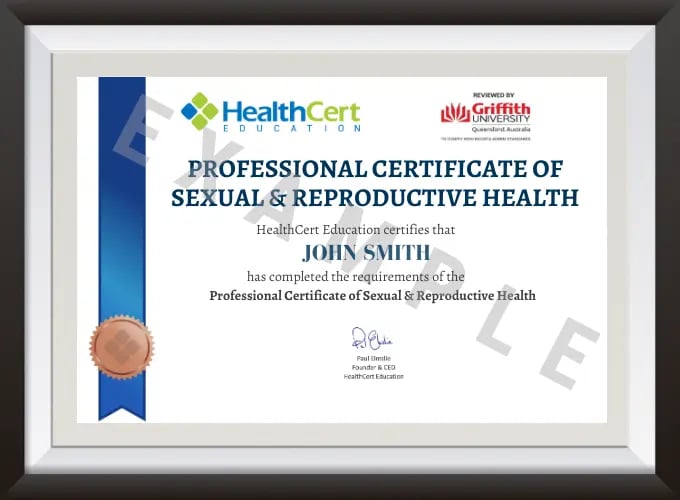Excision is routine work in primary care, but deciding who should wield the scalpel isn’t always...
.jpg?height=200&name=HCE%20HubSpot%20blog%20images%20600x350%20(22).jpg)
Gain comprehensive knowledge on the management of sexual and reproductive health conditions, especially for women.

Learn to safely screen, diagnose and treat common sexual health and reproductive concerns for patients presenting to general practice.
- Provide high-demand services for your female patients in the management of menstrual problems, endometriosis, pelvic pain, ovarian cancer, family planning, PCOS, vaginal prolapse, urinary incontinence, familial risk of breast and ovarian cancers, STIs, and cervical screening.
- This course is for medical doctors, International Medical Graduates, registered nurses and degree-qualified health professionals.
- CPD-accredited and university-reviewed.
Fulfils 50 hrs for medical professionals in Australia*
100% online
$1595
Special rates available
94 hrs
Self-paced
- Offer comprehensive care for patients with menstrual irregularities and related concerns.
- Provide early detection of endometriosis, pelvic pain, and ovarian cancer to improve patient outcomes.
- Educate patients about a wider range of reproductive and hormonal health options to assist with family planning.
- Effectively diagnose and manage PCOS to improve your patients’ quality of life.
Looking for focused, practical training in a particular sexual health procedure? You may also be interested in the Advanced Workshop of Non-Scalpel Vasectomy or the Advanced Workshop of Intrauterine Systems.
This women’s health module on menstrual irregularities defines common menstrual problems including abnormal menstrual bleeding, dysmenorrhea and premenstrual dysphoria. It includes classification systems, diagnostic criteria, and clinical guidelines for management and treatment of each condition. It offers resources and guidance for treating women presenting with associated symptoms or meet the diagnostic criteria for these disorders. Each condition is discussed including specific guidelines and treatment aims. Screening tools, indications for additional investigations, and appropriate examinations are recommended for diagnosis of each condition. The module discusses prevalence, common symptoms and potential patient impacts of menstrual irregularities.
This module recognises that pelvic pain experienced by women can significantly impact their quality of life. Given the complex anatomy of the pelvis and lower abdomen, pelvic pain presents a diagnostic challenge that requires clinical awareness to ensure the detection of serious conditions including endometriosis and ovarian cancer. This module provides practitioners with clinical reasoning models to effectively assess and diagnose acute, chronic, or recurrent pelvic pain including diagnostic models and management guides. Three case studies on women of different ages and conditions illustrate the application of Murtagh’s self-posed questions. There are separate units focused on endometriosis and ovarian cancer and the summary provides a systematic approach to identify, diagnose and manage the various forms of pelvic pain.
This module discusses the uses, effectiveness, and options for contraception and expands on the role of general practitioners in this area. It creates a detailed framework for making decisions about contraceptives including how to counsel patients about options, recommended examinations, information gathering, patient preferences and other factors to consider. Multiple options for contraception, comparisons of efficacy, delay in return to fertility and STI protection are discussed. Referencing the MEC guidelines, content delineates precautions and contradictions to consider when determining the suitability of contraceptive methods for individual patients. It discusses the differences of combined hormone contraceptives and progesterone-only pills and expands on the risks, side effects, benefits, contraindications, and implementation procedures for each approach. The module provides guidance for contraception at menopause and emergency contraception.
This module discusses the role of general practitioners in contraceptive counselling including comprehensive information on long-acting reversible contraceptives (LARCs). The nature of LARCs means that there is no difference between typical and perfect use. Their contraceptive effectiveness is outlined. Medical eligibility criteria for contraceptive use are applied to three types of LARC and includes important contraindications. It also presents discussion about the use of LARCs including how a clinician can reasonably exclude pregnancy and institute emergency contraception when warranted. Because of the suitability of LARCS for adolescents, content includes issues of consent and identifies key points of legislation related to informed consent. It also considers the termination of unintended pregnancy from request through to clinical referral. Finally, there is a discussion about the “quick start” method of contraception for women at higher risk of unintended pregnancy.
This module commences with the description of the different phases of the menstrual cycle and natural family planning methods options. These include fertility awareness, lactational amenorrhoea and withdrawal methods, their effectiveness, advantages, disadvantages and contraindications. Unit two outlines contraceptive needs in women with intellectual disability including legal considerations. Unit three addresses the complexities for women who are culturally and linguistically diverse, including the clinical challenges associated with this group. Statistics, factors influencing contraceptive choices and GP management recommendations are included. Key points of diagnosis, investigations, management, expected response and potential side effects are suggested. This unit also lists resources including public funded interpreter information. Information is provided for GPs working with Aboriginal and Torres Strait Islander women. At the end of this module an overview of new contraceptive products is given.
This module examines the prevalence, presenting symptoms, contributing factors and underlying problems associated with PCOS. Common features, risk factors and indications for further investigation to diagnose this condition are outlined. A framework for applying diagnostic criteria including presenting symptoms, specific criteria for diagnosis, and the process for eliminating other potential causes and conditions is provided. Tools and resources for screening and management of the condition are included. The module concludes by outlining symptoms of complications to look for and provides instructions for detection and management of these symptoms.
This module discusses urinary incontinence and pelvic organ prolapses. Content outlines the types of incontinence, symptoms, diagnosis, prevalence, the causes and the risk factors. Prolapses covered are the anterior and posterior vaginal walls, cervix or uterus and the apex of the vagina. Managing these presentations includes taking a detailed medical and obstetric history, investigating risk factors, physical examination and further investigation options. Questionnaires are provided as a guide for these consultations. Changes are discussed as well as continence aids. Various treatment options including lifestyle interventions, physical therapies, bladder training, medicines and continence aids are outlined. Surgical intervention and the associated risks are considered.
This module discusses genetics including information, counselling and statistics for hereditary, familial and sporadic distribution of cancer. The role of genes is also examined. Unit two looks at hereditary breast and ovarian cancer and the associated genes. Content includes referral guidelines, BRCA carrier risks, genetic counselling, identifying, and managing patients who are at high risk of hereditary cancers. Genetic testing information includes advances, testing processes and possible funding options, consent requirements, possible results and genetic variant classifications. The module covers management strategies for high-risk breast and ovarian cancer patients including psychological and lifestyle choices, communicating genetic results and informing family members. Counselling considerations including pros and cons for reproductive options, prenatal testing, pre and implantation genetic diagnosis and the role of IVF are included.
This women’s health module is separated into two units: Sexually transmitted infections (STIs) and Cervical screening.
Unit one identifies several STIs and other conditions associated with sexual activity. It outlines common features and symptoms, routes of transmission, key risk factors for infection and the prevalence of infection. The unit emphasizes the importance of early recognition, diagnosis, and treatment of STIs and details the natural progression of each condition if left untreated. Comprehensive information is provided about screening tools and procedures, examinations and testing, and detailed treatment plans. Information is included on contact tracing, notification of proper authorities and opportunistic counselling of patients about prevention of STIs.
Unit two begins with an explanation of the anatomy and functions of the cervix and identifies underlying causes and risk factors for cervical health issues including HPV, cervical dysplasia and cervical cancer. Indications for further investigation including presenting symptoms, risk factors, and potential impacts are covered. Information about current screening tests and ethical considerations related to patient experience and consent are addressed. Important updates in administrative processes, terminology for reporting and models for cervical screening results are explained. The module recognises the inherent limitations of these tests and emphasizes their role as one part of the diagnostic process.

Certificate of Family Planning, Graduate Diploma of Medical Education
Associate Professor Debbie Kors is the founder and joint owner of a private teaching general practice in Port Macquarie, Australia. She works there as a general practitioner and GP supervisor of GP registrars and medical students.
A/Prof Kors is a passionate advocate for the profession of general practice. She is a Conjoint Associate Professor in Primary Health Care at the UNSW Rural Clinical School, Port Macquarie campus and has previously worked as a senior medical educator with North Coast GP Training. In 2010, she was nominated for and won the General Practice Education and Training GP Supervisor of the Year award.
A/Prof Kors holds a MBBS (first class honours), Fellowship of the RACGP, Masters of Family Medicine (clinical), Diploma of the Royal Australian College of Obstetricians and Gynaecologists, Graduate Diploma of Medical Education and a Certificate of Family Planning.

Dr Christine Ahern has worked as a general practitioner in rural NSW since 1983, often with Aboriginal and Torres Strait Islander communities. Her special interests include women’s health and education.
Dr Ahern is a senior lecturer at Sydney University and has previously been the Director of Training for North Coast GP Training. In 2011 she was named the General Practice Education and Training Medical Educator of the Year, a prestigious national award. Dr Ahern holds a MBBS and FRACGP.




Belinda Dopita is an HGSA certified genetic counsellor with over 19 years’ clinical experience. She completed her undergraduate degree at the ANU, and her postgraduate diploma in Genetic Counselling at Melbourne. She worked at the Center for Human Genetics in Boston, USA. After returning to Australia, Belinda completed her Master's in Genetic Counselling studying physician knowledge of newborn screening, while working at The Children's Hospital at Westmead.
Belinda currently works at the ACT Genetic Service in both general and cancer genetics. She supports many cancer support groups and has presented at pink hope information days. Belinda also has a private practice which she founded in 2014. Her private practice has since grown, and she offers a combination of in-person appointments, skype and phone consultations. She is responsible for discussing high risk non-invasive prenatal test (NIPT), and reproductive carrier screening results Australia-wide. She has a particular interest in pre-pregnancy and prenatal genetic counselling as well as genetic testing for genes associated with cancer.
Belinda is the current ACT state representative for the Human Genetics for Australasia and has a long history of service with the HGSA. Having a background in psychology and previously working with children in many areas, she is also interested in genetic counselling of children and young adults.
Belinda has three children which keep her busy; she enjoys horse riding, dining out and any free time she can get.
$1595
*provided an outcome measurement activity with a minimum of 5 hours is completed.
Bundle two courses and save 5%, or three courses and save 10% upon enrolment.
Talk to us about deferred payment options, registrar scholarships and special rates.
*For Australian residents only: Online course prices are shown exclusive of GST. If you are GST-registered, please enter a valid ABN at checkout to ensure GST is not applied. Otherwise, 10% GST will be added at checkout. View our FAQ for more information.


HealthCert courses have become the standard by which you gauge all others.
Dr K. Abolarinwa
Good courses with excellent speakers. I particularly enjoyed the case study scenarios which helped to integrate the knowledge gained.
Dr A. Tucker
This is the pathway to improve your confidence and evolve into the GP you aspire to be.
Dr S. Shinwari
| RACGP Activity Number | ACRRM Activity Number | Activity Title | Education Hours | Performance Hours | Outcome Hours | ||
|---|---|---|---|---|---|---|---|
| 455749 | 31186 | Family Planning | 455749 | 31186 | 4 | 6 | 0 |
| 473783 | 31197 | Vaginal Prolapse and Urinary Incontinence | 473783 | 31197 | 4.5 | 6 | 0 |
| 473819 | 31202 | Familial Risk of Breast and Ovarian Cancer | 473819 | 31202 | 5 | 6 | 0 |
| 469363 | 31189 | Endrometriosis | 469363 | 31189 | 5 | 6 | 0 |
| 455707 | 31182 | Polycystic Ovarian Syndrome | 455707 | 31182 | 4.5 | 6 | 0 |
| 455695 | 31181 | Sexually Transmitted Infections (STI) | 455695 | 31181 | 5 | 6 | 0 |
| 469379 | 31191 | Family Planning (Advanced 1) | 469379 | 31191 | 4.5 | 6 | 0 |
| 473801 | 31199 | Family Planning (Advanced 2) | 473801 | 31199 | 4 | 6 | 0 |
| 455734 | 31185 | Menstrual Irregularities | 455734 | 31185 | 3.5 | 6 | 0 |
| 807815 | 33015 | Premature ovarian insufficiency Outcome Improvement Activity | 807815 | 33015 | 0 | 0 | 8.5 |
| Total hours | 40 | 54 | 8.5 | ||||
View the CPD Hours for all HealthCert Education activities.
The purpose of outcome measurement activities is to improve your clinical confidence in managing an identified learning gap. Outcome measurement activities are not a requirement of our Professional Certificate of Advanced Certificate courses; they are a requirement for Australian CPD purposes.
HealthCert Education provides a variety of outcome measurements activities to suit your needs:
The Professional Certificate of Sexual & Reproductive Health is for medical practitioners who wish to manage common sexual health issues to improve patient outcomes in general practice. This course is for physicians and degree-qualified medical professionals. There are no prerequisites.
Participants do not have to pass an IELTS test but, as the courses are delivered in English, proficiency in listening, reading and writing English is assumed.
Participants will require access to a computer/laptop, an internet connection and a basic level of technology proficiency to access and navigate the online learning portal.
HealthCert alumni who have successfully completed all of the following courses may enrol in the alumni RPL version of this course at a reduced fee because some modules have already been studied:
Further professionally recognised qualifications and prior studies may be recognised for entry into this course if the learning outcomes match exactly. Please ask a HealthCert Education Advisor for an individual assessment of your prior qualifications and experience.
This certificate course meets the minimum 50 hours CPD annual requirement across all three mandatory CPD activity types, provided an outcome measurement activity with a minimum of five hours is completed. You may use an optional HealthCert outcome measurement activity or develop your own.
Outcome measurement activities are not a requirement of Professional or Advanced Certificates.
Upon successful completion of the course requirements, course participants will receive the Professional Certificate of Sexual & Reproductive Health and CPD hours.
This certificate course:
To learn more about the delivery of certificates in Australia and overseas, please visit our FAQs.
Professional Diploma Pathway
This course is the first stage of the professional diploma pathway. The full pathway is: Professional Certificate of Sexual & Reproductive Health, Advanced Certificate of Sexual & Reproductive Health, Professional Diploma of Sexual & Reproductive Health.
Postgraduate Pathway
Graduates of the HealthCert Professional Diploma of Sexual and Reproductive Health qualify for a scholarship into the Master of Science: Sexual and Reproductive Health. This is an online course from the UK designed for medical practitioners. Please contact our UK partner directly regarding this scholarship: https://www.diploma-msc.com/s/healthcert
This organisation is an RACGP-accredited CPD provider under the RACGP CPD Program.




Don't see your question? Explore other faqs or talk to us.
Fees will vary based on the program and study option selected (fully online vs online + optional practical workshop). Payments can be made upfront or in monthly instalments. Special rates and various payment options are available. GP registrars and doctors in training enjoy a scholarship of up to $500. Talk to us to learn more.
Completion of any HealthCert course or attendance at an event will enable you to access the HealthCert Alumni Program which includes:
HealthCert Education is pleased to issue digital credentials for alumni. Digital credentials are a permanent online record of your successful completion of a HealthCert course and are issued to all course participants in addition to PDF certificates. If you are based in Australia, you also have the option to order a hard copy of your digital certificate for a small additional fee.
The recommended study duration of this certificate course is 94 hours, which includes study of the pre-course activities and readings, online lectures, live tutorials, and online assessment. This self-paced course offers the flexibility of 100% online study in your own time, at your own pace, in your own home or office, with no mandatory face-to-face requirements. You are not required to be online at specific times but can view and replay video lectures at your convenience.
All HealthCert courses meet World Federation of Medical Education standards. This certificate course qualifies for CPD hours from the Royal Australian College of General Practitioners (RACGP) and the Australian College of Rural and Remote Medicine (ACRRM) in Australia. It is recognised by the Royal New Zealand College of General Practitioners (RNZCGP) in New Zealand. It is recognised by the Hong Kong College of Family Physicians (HKCFP) in China. It is a self-submitted activity in Dubai and the United Kingdom. It is a self-submitted activity through the College of Family Physicians in Canada. If you live or work outside one of the above-mentioned countries, please contact us on admin@healthcert.com to discuss whether this course can be recognised in your country.
Want to stay up-to-date with the latest case studies, podcasts, free video tutorials and medical research articles pertinent to primary care?
Our Education Advisors can assist you with any queries and tailor our education pathway to suit your current expertise, interests and career goals.